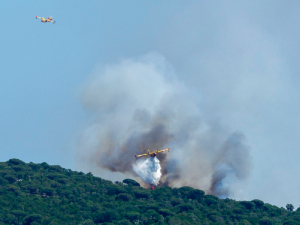Challenges of institutional adaptation
Nature Climate Change volume 15, page 683 (2025)

The increasing frequency, duration and scale of hazards under climate change is putting strain on institutional capacities. However, the challenges of institutional adaptation are rooted in the complexity of the physical and ecological processes impacted by climate change. These processes are interconnected and often unpredictable, making it difficult for institutions to anticipate, plan for and respond to emerging risks. For example, the impacts of wildfires on forests depend on local conditions, with cool, wet forests more vulnerable to the changes in microclimate caused by fire compared with warm, dry settings2. It is thus difficult to manage the associated risks and damages effectively through traditional institutional frameworks that are often plagued by inertia and weak coordination. A practical scientific understanding of these complex biophysical processes is a necessary first step towards informing effective institutional adjustments and policy responses.
In addition, biophysical processes are often intertwined with socioeconomic processes, further complicating the management of adaptation efforts. For example, deltas face multiple natural hazards under climate change, and are additionally impacted by anthropogenic activities such as dam construction. This confluence of environmental and anthropogenic factors makes anticipating the full impacts of a decision difficult for the responsible institutions and stakeholders. In a Comment, Sepehr Eslami and colleagues underscore the need for integrated systems understanding, coordinated efforts and holistic decision-making in adaptation, with particular focus on the smaller scales at which implementation is more likely.
Constraints also emerge from the institutional landscape itself. Governance systems responsible for either a particular event or adaptation initiatives more broadly are rarely streamlined. Instead, they are often fragmented, characterized by overlapping jurisdictions, misaligned priorities and institutional inertia. For example, authority for managing wildfires is fragmented across a mosaic of local, state, federal and tribal jurisdictions3, and evidence from Nowell and colleagues’ work indicates the overall increased jurisdictional complexity of US wildfires. Emergency management frameworks, forest service protocols and inter-agency coordination mechanisms often struggle to cope with multi-jurisdictional fires, simultaneous outbreaks across regions, and the long-term health and ecological consequences. Also, trade-offs between short-term political gains and long-term resilience, and between centralized control and local agency, may hinder adaptive decision-making among the departments. Social hierarchies and resource disparities further complicate efforts, by creating unequal capacities, priorities and access to decision-making processes4.
The challenges of institutional adaptation could be particularly acute in marginalized regions that face heightened environmental stress — through deforestation, biodiversity loss, water scarcity and extreme events — yet often lack the cohesive institutional architecture needed to respond effectively5,6. The critical limitations include the lack of regulatory enforcement, political resistance in implementation, lack of processes for sharing resources among institutions, lack of equity consideration and inadequate financial resources7. Here, institutional adaptation is also constrained by a lack of awareness that institutions themselves must evolve along with climate change. Climate change adaptation in these regions should be closely aligned with socioeconomic development and capacity-building efforts. A coordinated policy framework is necessary to navigate trade-offs among competing priorities.
Adaptation is often framed as a technical or behavioural challenge, rather than one of governance. Institutional adaptation will not be easy and there will not be a one-size-fits-all solution, but it is necessary. It needs to evolve in line with the changing climate and be grounded in the local environmental and governance contexts.
References
Comfort, L. & Chang, S. Risk Analysis https://doi.org/10.1111/risa.70015 (2025).
Wolf, K. D., Higuera, P. E., Davis, K. T. & Dobrowski, S. Z. Ecosphere 12, e03467 (2021).
Jones, K., Vukomanovic, J., Nowell, B. & McGovern, S. Glob. Environ. Change 84, 102804 (2024).
Barnes, M. L. et al. Glob. Environ. Change 92, 102983 (2025).
Herrera, J. S. C. & MacAskill, K. Transport. Res. Part D 101, 103073 (2021).
Murunga, M., Partelow, S. & Breckwoldt, A. World Develop. 141, 105413 (2021).
Le, T. D. N. Mitigat. Adapt. Strat. Glob. Change 25, 739–761 (2020).
Challenges of institutional adaptation. Nat. Clim. Chang. 15, 683 (2025). https://doi.org/10.1038/s41558-025-02388-w
Published
Issue Date
DOIhttps://doi.org/10.1038/s41558-025-02388-w
Further Information
Jennifer Carman, Marija Verner & Marina PsarosComment | 20 June 2025 Nature Climate Change 15 | doi:10.1038/s41558-025-02369-zSepehr Eslami, Gualbert Oude Essink, Amelie Paszkowski, Katharina Seeger, Philip S. J. Minderhoud et al.Comment | 07 July 2025 Nature Climate Change 15 | doi:10.1038/s41558-025-02368-0

